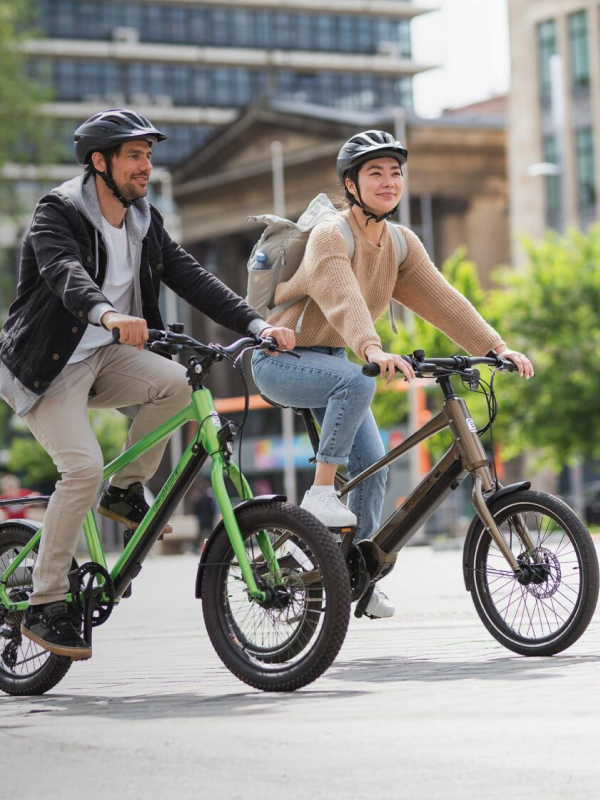Both electric scooters and electric bikes are enjoyable, practical, and green ways of transportation. They both have advantages and disadvantages that should be taken into account. They are excellent for commuters. The terrain you ride on, the lengths you travel, the amount of luggage you need to carry, and your personal preferences will all affect your ideal electric transportation option. This article will pit the pros and cons of electric scooters against e-bikes to assist you in making your decision. Range, speed, safety, comfort, portability, durability, price, and more will be discussed. We will also explore the best ways to charge your electric bike at home.
Charging electric bikes at home when you are away can be a hassle, with continued charging damaging batteries and putting a big number on your utility bills. Get EVVR Energy Monitoring Smart Plug to sort out your woes today!
- What Is An Electric Bike?
- What Is An Electric Scooter?
- Electric Bikes Vs. Electric Scooters
- How Much Does It Cost To Charge An Electric Bike?
- Charging At Electric Bike At Home
- Optimize Your Electric Bike Charging With EVVR Energy Monitoring Smart Plug
What Is An Electric Bike?
An e-bike, often known as an electric bike or e-bike, is a typical bicycle with an electric motor that assists the riders to pedal. A sizable battery powers the electric motor.
You can use an e-bike to help you go up hills, through headwinds, and on flat ground. You can maintain faster speeds with the motor as well as you could on your own. Depending on the class and engine size, the maximum speed of most e-bikes ranges from 15 to 28 mph.
There are numerous different electric bike designs. The majority of e-bikes come with a pedal assist option that only gives you power while you pedal. Some electric bicycles have a throttle control that lets you pedal-free ride.
What Is An Electric Scooter?
A stand-up scooter propelled by a tiny electric motor in the hub is known as an electric scooter or e-scooter. The motor can be in the front hub and the usual location in the back hub. A battery provides electricity to the motor.
The footboard or deck and the stem or bar comprise an electric scooter's two primary components. On top of the footboard, the rider stands. The bottom is where the wheels attach. The wheels on an electric scooter are two. The footboard contains the battery.
Straight up from the front of the footboard is a long bar or stem. To this stem, the handlebars are attached. This enables you to guide the scooter by turning the front wheel. Except for the larger stem, a scooter's fork and handlebars function exactly like a bicycle's.
The throttle control on the handlebars next to the grips lets you regulate the scooter's speed. While some electric scooters feature a twist throttle like a motorcycle, others have a thumb throttle.
You can get the best bang for your buck in saving electricity and the environment with your electric scooter or bike by simply connecting its charger with the EVVR Energy Monitoring Smart Plug. You can control the plug remotely and even get insights into energy consumption.

Electric Bikes Vs. Electric Scooters
Electric scooters are preferable for some riders. Electric bikes are a better choice for other riders. In this part, I'll list a few advantages and disadvantages of e-scooters and e-bikes to help you decide which form of electric mobility is best for you.
Comfort
Most riders find riding electric bikes more comfortable than riding electric scooters. The primary factor is that electric scooters lack a seat while electric bikes do.
E-bikes are ridden while seated. Riding an electric scooter requires standing up. It is almost always more comfortable to sit down when riding for longer than 15 to 20 minutes. An electric bike is almost always the preferable option for longer journeys. You won't want to remain stationary for extended periods.
E-scooters aren't uncomfortable, of course. Some people find it more comfortable to stand on shorter rides. While you're standing, your legs can function as a suspension mechanism. High-volume tires and suspension systems are available on more expensive scooters, greatly improving vibration and bump absorption. E-scooters with seats are also available. E-bikes and scooters both offer comfortable rides.
Range/ Battery Life
The fact that electric bikes have a longer range than electric scooters is one of their main benefits. An electric bike's range can range from 30 to 50 kilometers, depending on the battery size. With a dual battery system, some vehicles can achieve a range of up to 100 miles. In contrast, the typical range of an electric scooter is 20 to 25 kilometers. Electric bikes are superior to long commutes and excursions due to their greater range.
The footboard of the majority of electric scooters has just one battery. The battery has to be smaller because there is less space. On the majority of e-scooters, changing the battery is also difficult. It is a part of the footboard.
E-bikes' increased range is also a result of the battery's reduced requirement for electricity. When using a pedal-assist system, the rider contributes some pedaling force. As a result, the battery drips slowly. It is just carrying out some of the work.
You can prolong the battery life of your electric scooter by using EVVR Energy Monitoring Smart Plug. It can be controlled remotely and tell you about your electric bike's energy consumption during charge-ups.
Time For Charging
It is crucial to consider how often and for how long you typically recharge your electric car. You can modify your electricity rate based on this to maximize savings.
For instance, it would be advantageous to have a tariff like Tempo Happy 2 hours, which provides you two straight hours of power free every day if you frequently charge your scooter.
As with the One Luz 3 Time Periodos rate, if you charge for a longer period, it is best to take advantage of the time bands at night when electricity is less expensive.
It is in your best advantage to select one of the new flat-rate electricity tariffs if you would rather not be concerned about time bands for electricity, both for recharging your electric scooter or bicycle and for daily usage.
How Much Does It Cost To Charge An Electric Bike?
One of the main concerns on your mind while looking for a new electric bike is how much it will cost to charge. When deciding on your budget for your new e-bike, the cost of charging needs to be considered for anything from lightweight road e-bikes to heavy-duty hybrid cycles.

Electricity Costs
The energy cost in your location is one of the key elements that will decide how much it will cost to charge an electric bike. The price of electricity bills varies widely depending on where you reside. However, it costs between $0.10 and $0.05 per kWh in most American cities. According to EIA, the typical price in America is $0.13 per kWh. You can check with your local utility company to get the precise cost of power in your area.
Battery Capacity
The majority of electric bikes include lithium-ion batteries with capacities ranging from 250-watt hours (Wh) to 1,000 watt hours and higher. Larger capacity batteries typically require more time to charge but also provide better riding range. For instance, a 500-Wh battery will fully charge twice as slowly as a 250-Wh battery but also provide twice as much riding range. Knowing this information will enable users to pick the battery size that is ideal for them and estimate the cost of charging their electric bike.
Charging At Electric Bike At Home
A charging regimen is crucial for keeping your e-bike's battery charged and ready to go. But if you've never used an e-bike before, you might be perplexed about the battery part of it. We'll discuss the one topic frequently asked when buying your electric bike: Can I charge my e-bike at home? To ensure that you always have adequate battery %.
Your e-bike can indeed be charged at home. Even while charging stations are starting to appear, it is still more practical to do it at home. Most electric bikes have detachable batteries, so you can exchange one for one that is charged and ready. The procedure for replacing the battery is relatively straightforward:
- The e-bike's battery pack should be taken off.
- Make sure the battery pack switch is off, if there is one.
- Connect the cable to an electrical outlet.
- Link the battery to the charger.
- As with any lithium battery, it is not a good idea to leave the battery plugged in while you are away from home.
Once connected, an LED light should turn on or begin flashing to show that charging is taking place. Green indicates that it has been charged.

Optimize Your Electric Bike Charging With EVVR Energy Monitoring Smart Plug
Say you are out and plugged your electric bike to charge at home. Since you are away, you can't turn off the power outlet to avoid energy wastage and harm to the batteries of your electric bike. Instead of asking a neighbor to intervene, get an EVVR Energy Monitoring Smart Plug. This nifty device can do all the heavy lifting on your behalf to keep the electricity bill on the lower side and save you hassle along the way. So, what are you waiting for?















